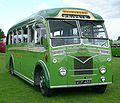Coach (bus)
This article needs additional citations for verification. (July 2009) |

A coach (also motor coach) is a large motor vehicle, a type of bus, used for conveying passengers on excursions and on longer distance express coach scheduled transport between cities - or even between countries. Unlike buses designed for shorter journeys, coaches often have a luggage hold separate from the passenger cabin and are normally equipped with facilities required for longer trips including comfortable seats and sometimes a toilet.
The term 'coach' was previously used for a horse-drawn carriage designed for the conveyance of more than one passenger, the passengers' luggage, and mail, that is covered for protection from the elements. The term was applied to railway carriages in the 19th century, and later to motor coaches (buses).
History
Horse drawn chariots and carriages ('coaches') were used by the wealthy and powerful where the roads were of a high enough standard from possibly 3000BC. In Hungary during the reign of King Matthias Corvinus in the 15th century, the wheelwrights of Kocs began to build a horse-drawn vehicle with steel-spring suspension. This "cart of Kocs" as the Hungarians called it (kocsi szekér) soon became popular all over Europe. The imperial post service, employed the first horse-drawn mail coaches in Europe since Roman times in 1650, - as they started in the town of Kocs the use of these mail coaches gave rise to the term "coach".[1] Stagecoaches (drawn by horses) were used for transport between cities from about 1500 in the United Kingdom until displaced by the arrival of the railways.[2]
One of the earliest motorised vehicles was the Charabancs which was used for short journeys and excursions until the early years of the 20th century.[citation needed] The first 'motor coaches' were purchased by operators of those horse-drawn vehicles in the early 1900s[3] by operators such as Royal Blue Coach Services who purchased their first Charabanc in 1913[4] and were running were running 72 coaches by 1926.[5]
Features


Coaches vary considerably in quality from country to country and even within counties. Higher specification vehicles include reclining upholstered seats, air-conditioning, overhead luggage compartments, and passenger-controlled aircraft-style PSU units. Other passenger amenities include small tables for small snacks, small video screens to show TV shows, videos, and/or movies, and even a beverage station. Larger items of luggage are stored below the floor in the undercarriage luggage compartments, and are accessible from outside panels. A toilet will normally be included. Coaches typically have a single door and possibly also a wheelchair-lift access.
Manufacture
Major manufacturers include Plaxton, Neoplan, Marcopolo, Irizar, Scania and many others. It is reasonably common for one manufacturer to build and supply a chassis and for another to then construct the 'coachwork' (the passenger compartment) onto this chassis.
Gallery
Modern coaches
A representative selection of vehicles currently in use in different parts of the world.
-
A 56 passenger Prevost coach
-
Victory Liner Inc. Provincial Coach (made by Del Monte Motor Works, Inc. on a MAN 16.290 HOCL chassis) (Philippines)
-
A double-decker Neoplan Jumbocruiser
-
The 23 seater 250 km/h prototype superbus
Vintage coaches
A selection of vehicles in use in different parts of the world in the past.
-
Bedford 1961 coach owned by MacBraynes Bus
-
An early 1980s Mitsubishi Fuso coach with FHI body
-
Short bodied Dennis 1931 King Alfred
-
Greyhound MCI MC 6 coach built by Motor Coach Industries
See also
- Carriage
- Coach (carriage)
- Coach of the year in China
- Coach transport in the United Kingdom
- Double-decker bus
- Family Motor Coach Association
- List of buses
- Sleeper bus
References
- ^ Mackay, James (1988). The Guinness Book of Stamps. Guinness Publishing LTD, Enfield, UK. p. page 26.
{{cite book}}:|page=has extra text (help) - ^ Dyos, H. J. & Aldcroft, D.H. (1969) British Transport, an economic survey Penguin Books, p.225
- ^ W C Standerwick Ltd by Peter Gould
- ^ Anderson & Frankis, p.28-9
- ^ Anderson & Frankis, p.41
- Anderson, R.C.A. and Frankis, G. (1970) History of Royal Blue Express Services David & Charles












